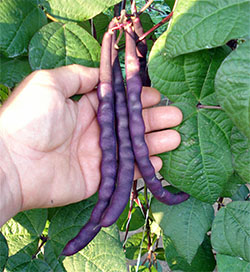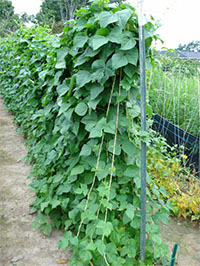Heirloom Beans
Heirloom beans are vintage varieties of the warm-season crop (Phaseolus vulgaris) that have been handed down from generation to generation. There is a long tradition of saving bean seed in Appalachia, and heirloom beans are sought by customers at Kentucky farmers markets. Heirloom bean varieties, often named after particular areas or families, appeal to buyers because of both taste characteristics and cultural heritage. Heirloom bean varieties were often selected for their eating quality when the beans were mature or nearing maturity. This makes heirloom types different from modern stringless green bean varieties, which are usually picked when the beans are at an immature green stage.
Marketing
 Sales of heirloom beans at the Lexington Farmers Market date back to the early 1970s. The popularity and availability of heirloom beans grew as the number of Kentucky community farmers markets increased between 1998 and 2008. Farmers markets remain an important marketing channel for heirloom beans. Other fresh market options include community supported agriculture (CSA) subscriptions, on-farm sales and roadside stands. Small-volume wholesaling to local grocery stores and restaurants is also an option. Bean names often include references to bean appearance and growth habit, and producers may need to educate customers about what traditional names mean. “Greasy” bean varieties lack fuzzy skins, giving the hulls a shiny or greasy luster. “Cut-short” beans are varieties where beans grow tightly together in the hulls, resulting in a squared-off or “cut short” hull. Heirloom beans can also be described by their growth habit: bush, half-runner and pole (or cornstalk) beans. Heirloom beans have a particular appeal to customers interested in traditional and heritage cuisine. Flavorful or novel varieties can be rapid sellers at farmers markets and farm stands. In addition, heirloom bean varieties fit into the appeal of local cuisine at fine dining and niche restaurants. The National Restaurant Association ranked hyper-local cuisine and vegetable dishes as two of the hottest trends in restaurant cuisine in 2018. Fresh market green bean usage in the U.S. also remains steady, on a per capita basis, according to the USDA.
Sales of heirloom beans at the Lexington Farmers Market date back to the early 1970s. The popularity and availability of heirloom beans grew as the number of Kentucky community farmers markets increased between 1998 and 2008. Farmers markets remain an important marketing channel for heirloom beans. Other fresh market options include community supported agriculture (CSA) subscriptions, on-farm sales and roadside stands. Small-volume wholesaling to local grocery stores and restaurants is also an option. Bean names often include references to bean appearance and growth habit, and producers may need to educate customers about what traditional names mean. “Greasy” bean varieties lack fuzzy skins, giving the hulls a shiny or greasy luster. “Cut-short” beans are varieties where beans grow tightly together in the hulls, resulting in a squared-off or “cut short” hull. Heirloom beans can also be described by their growth habit: bush, half-runner and pole (or cornstalk) beans. Heirloom beans have a particular appeal to customers interested in traditional and heritage cuisine. Flavorful or novel varieties can be rapid sellers at farmers markets and farm stands. In addition, heirloom bean varieties fit into the appeal of local cuisine at fine dining and niche restaurants. The National Restaurant Association ranked hyper-local cuisine and vegetable dishes as two of the hottest trends in restaurant cuisine in 2018. Fresh market green bean usage in the U.S. also remains steady, on a per capita basis, according to the USDA.
Production

Most heirloom snap bean varieties are “string beans,” named because of the fiber or string running along the pod seam. String beans have at least one string per side, which need to be removed before the beans are cooked or dried. Stringless beans, first selected in the 1890s, dominate commercial vegetable bean production; however, many consumers still prefer the flavor and texture of the stringed types, as stringless beans tend to be tough. Heirloom beans are most often pole types, with a smaller number of bush types, compact plants 1 to 2 feet in height. Pole or “cornfield” beans produce vines that may reach 8 to 10 feet or more in length. Half-runners have a growth habit between bush and runner, producing vines that are at least 3 feet long and sometimes much longer. Typically, pole beans set pods over a longer period of time than bush beans. Pods of either type may be round or flat in shape. While green is the most common color, pods may be yellow (wax beans), purple or streaked. Unique and novel colorations add to the appeal of many heirloom varieties. Heirloom pole beans and half-runners will require the construction of a trellis or other support before the plants begin to produce runners. There are different types of supports that can be built or strung, including manufactured trellis material. Producers should match the type and style of trellising with their field situation and farm resources.

